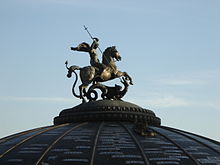- Manezhnaya Square, Moscow
-
For other uses, see Manezhnaya Square.
Coordinates: 55°45′21″N 37°36′53″E / 55.75583°N 37.61472°E
 In Manege Square looking toward the Alexander Garden
In Manege Square looking toward the Alexander Garden
Manezhnaya or Manege Square (Russian: Манежная площадь, Manezhnaya ploshchad) is a large pedestrian open space at the heart of Moscow bound by the Hotel Moskva to the east, the State Historical Museum and the Alexander Garden to the south, the Moscow Manege to the west, and the 18th-century headquarters of the Moscow State University to the north.
The square forms a vital part of downtown Moscow, connecting Red Square (which sprawls behind the Iberian Gate immediately to the south) with a major traffic artery, Tverskaya Street, which starts here and runs northward in the direction of Saint Petersburg. It is served by three metro stations: Okhotny Ryad, Ploshchad Revolyutsii, and Teatralnaya.
History
The Manezhka (as it is familiarly known) had its origins in Moiseyevskaya Square, which was formed in 1798 in consequence of the demolition of the medieval Moiseyevsky Monastery which used to stand on the banks of the Neglinnaya River since the times of Ivan the Terrible. Although the muddy river was earthed up, the neighbourhood remained crammed with public houses and taverns which gave the area its infamous moniker of "Moscow's belly".
A decision was arrived at in 1932 to pull down these "ugly relics of the bourgeois lifestyle" in order to make room for Communist meetings and demonstrations. As a result, the 19th-century Grand Hotel and several Neoclassical mansions by Osip Bove were dismantled, whereupon the Moiseyevskaya Square was expanded to its present size and renamed Manezhnaya after the Manege it now abutted upon.
Notwithstanding its new name, the eastern side of the square came to be dominated by another building, the newly-built Hotel Moskva, a hybrid of several styles, most notable for its huge proportions and uptight look.
In 1967, the square was renamed after the 50th Anniversary of the October Revolution. Furthermore, in order to commemorate that event, the Communist authorities laid a foundation stone for a grandiose sculptural monument, which failed to materialize. In August 1991, Manezhnaya Square (its name by then restored) became a venue for great demonstrations celebrating the fall of Communism after the abortive coup d'état. More recently, it made the news in connection with riots following the Russia national football team's defeat at the 2002 FIFA World Cup. The place has been a stage of rioting again in December 2010, when thousands of youth representing football fans and/or those who support nationalist slogans held a rally at Manezhnaya which turned violent.[1] It resulted in many local rioting and ethnically motivated violence across Moscow and nationwide[2][3] and made the square's name common in media when it comes to growth of nationalist sentiments in modern Russia.[4]
Reconstruction
During the 1990s, the Moscow mayor Yury Luzhkov had the square closed to traffic and substantially renovated. The centrepiece of the renovated square is a modern trade centre, with four underground storeys and parking lot capped with a rotating glass cupola, which forms a world clock of the Northern hemisphere with major cities marked and a scheme of lights below each panel to show the progression of the hour. Another innovation is the feign river-bed of the Neglinnaya River, which has become a popular attraction for the Muscovites and tourists alike, especially on sultry days of summer. The river's course is imitated by a rivulet dotted with fountains and statues of Russian fairy-tale characters, as sculpted by Zurab Tsereteli. In 1995, Vyacheslav Klykov's equestrian statue of Marshal Zhukov was unveiled in front of the State Historical Museum to mark the 50th anniversary of the Moscow Victory Parade, when the Soviet commander had spectacularly rode a white stallion through Red Square and Manege Square.
References
- ^ http://rt.com/news/football-police-clash-moscow
- ^ http://rt.com/news/ethnic-moscow-live-pictures/
- ^ http://www.bbc.co.uk/news/world-europe-12003358
- ^ http://vz.ru/columns/2010/12/12/454255.html
- Векслер А.Г., Пирогов В.Ю. Манежная площадь в Москве. История освоения и застройка территории, в сборнике: Архитектура в истории русской культуры. М., 1996.
-
Glass cupola crowned by a statue of Saint George, holy patron of Moscow, with the Manege looming in the background (western side)
-
View on the State Duma (northern side)
-
View on the Hotel Moskva (eastern side)
-
View on the Alexander Garden (southern side)
-
View on the Manezhnaya Square from the beginning of Tverskaya Street
Categories:- Parks and gardens in Moscow
- Squares in Moscow
Wikimedia Foundation. 2010.







